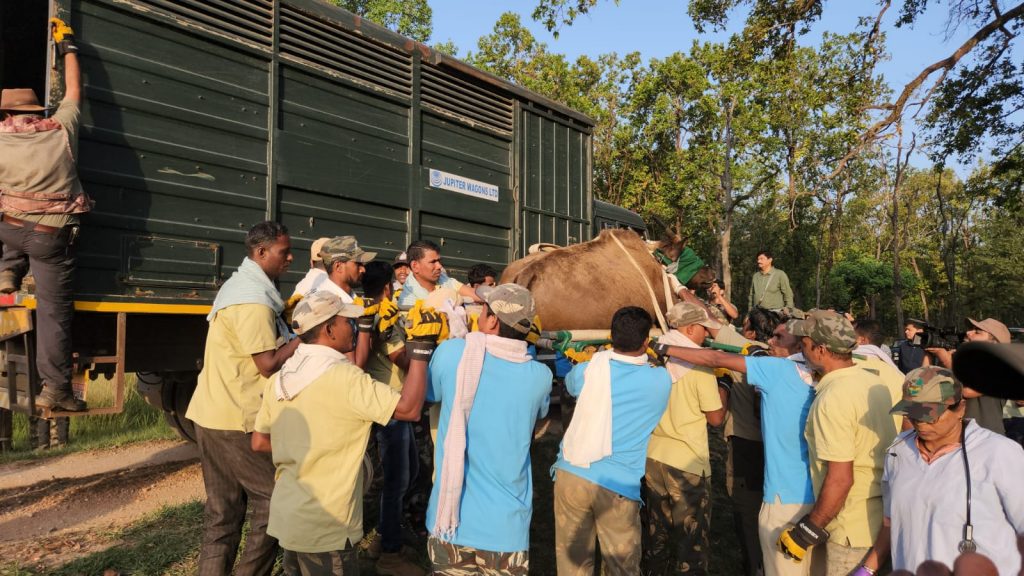In what was one of the largest mega-herbivore translocations in India, particularly for improving the heterogeneity of the existing population, 28 Gaurs were successfully translocated from Kanha Tiger Reserve to Sanjay Dubri Tiger Reserve, both in Madhya Pradesh.
This translocation was done in order to repopulate the animal in Sanjay Dubri Tiger Reserve after its Gaurs started disappearing in the 90s. The last Gaur was documented here in 1997.
Indian Masterminds spoke to CCF & Field Director of Kanha Tiger Reserve, Mr. Sunil Kumar Singh, and CCF & Field Director of Sanjay Dubri Tiger Reserve, Mr. Amit Dubey, to get more details about the translocation and the successful reintroduction.

WHY GAURS DISAPPEARED FROM SANJAY DUBRI
According to Field Director of Kanha, Sunil Kumar Singh (IFS 2000), after the bifurcation of the state of Madhya Pradesh into two – Chhattisgarh and MP – 70 percent of the Sanjay Tiger Reserve landscape went to Chhattisgarh. “As the landscape was contiguous, the Gaurs on the MP side started moving towards the Chhattisgarh side. This migration happened largely around 1996-97,” he said.
The Chhattisgarh part is now known as the Guru Ghasidas Tiger Reserve. However, Gaurs gradually started disappearing from the entire landscape consisting of Bandhavgarh, Sanjay Dubri, Guru Ghasidas, and Palamu. Only a few insignificant evidences were observed, mostly of loner Gaur, on the Chhattisgarh side till recently.
As for Sanjay Dubri Tiger Reserve, its Field Director Amit Dubey (IFS 2001) said that Gaurs were here till the late 90s. After that, they became extinct and were wiped out from the entire landscape. He attributed the extinction to several factors. “The last Gaur was documented in 1997. The reasons for the extinction were never really established. Might be due to multiple reasons,” he said.
GAUR REINTRODUCTION IN BANDHAVGARH
Earlier, in 2011-12, Gaur reintroduction programme was introduced in Bandhavgarh National Park with translocation of the animals from Kanha. This turned out to be quite successful in terms of multiplication of source population almost three times in 10 years.
“In the same way, Gaurs are being reintroduced in Sanjay Dubri to restore lost bio-diversity,” Mr. Dubey said.
TRANSLOCATION OF 28 GAURS
The translocation of 28 Gaurs from Kanha to Sanjay Dubri was carried out from 1 to 7 June. A team of 65 people took part it it. The team, that included forest officials, veterinary doctors, and wildlife experts, was led by the then Chief Wildlife Warden of the state, Mr. Jasbir Singh Chouhan.

Four customised transportation vehicles were used for the translocation. The Gaurs were first tranquilised and then carefully placed inside the vehicles. “On a particular day, minimum 2 to maximum 6 Gaurs were taken to Sanjay Dubri from Kanha. Each vehicle has two chambers. Depending on the sizes, we could accommodate 3-4 Gaurs in each vehicle. If a Gaur was very big, we gave him one chamber and placed two smaller ones in the other,” Kanha Field Director Sunil Kumar Singh informed.
As this translocation was carried out in the harsh summer, when Madhya Pradesh was experiencing around 40-42 degree celsius, wet foams were placed on the roof of the vehicles and exhaust fans and showers were fitted inside. These showers sprinkled water on the Gaurs from time to time. All this was done to maintain a suitable temperature between 32-33 degree celsius.
The Gaurs were accompanied on their journey of 14-16 hours by wildlife experts, forest staff, and veterinary doctors. “There were 12 doctors in the team. The technical support was provided by WWI, who was our partner. Also, scientists and vets from the School of Wildlife Forensic and Health in Jabalpur and forest officials from all the tigers reserves in MP oversaw the operation,” Mr. Singh said.

GAURS IN THEIR NEW HOME
All 28 Gaurs brought from Kanha are now roaming free in Sanjay Dubri Tiger Reserve, exploring the landscape. Few of them even cross over to the Chhattisgarh side at times. “It will take another 2-3 months for them to mark their home range and settle down,” Sanjay Dubri Field Director Amit Dubey said.
However they are monitored carefully by doctors as well as the forest staff. Few of them have been fitted with VHF (Very High Frequency) collars while few others have been fitted with collars with colour codes.
“So, either through the signals from the VHF collars or through binoculars, we can keep track of the herds. By picking out a particular coloured collar in one or two Gaurs through binoculars, we can make out which herd it is,” the officer explained.

It’s been more than a month now since the Gaurs from Kanha arrived in Sanjay Dubri Tiger Reserve. On their arrival, they were kept in a 28-hectares enclosure for about 15 days for close monitoring, and then let out to roam free in the landscape.
15 MORE GAURS FROM SATPURA
However, the enclosure has new members now. The Kanha Gaurs’ place has been taken by 15 Gaurs brought from the Satpura Tiger Reserve. And, now, they are waiting to be released into the wild, which, Mr. Dubey said, is likely to happen in a few days from now.

































